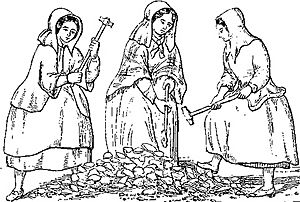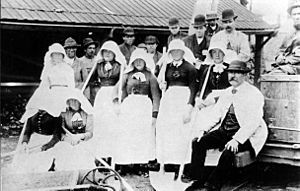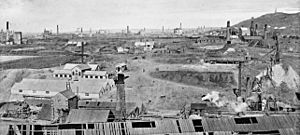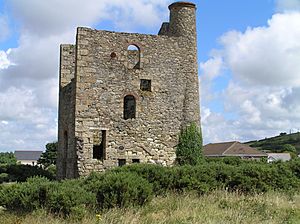Bal maiden facts for kids
A bal maiden was a girl or woman who worked in the mines of Cornwall and western Devon, in the southwest of Great Britain. The word "bal" comes from the Cornish language and means "mine." The term "bal maiden" has been used since at least the early 1700s. Over 55,000 women and girls worked as bal maidens throughout history, and the real number was probably even higher.
Unlike women who worked in coal mines elsewhere in Britain, bal maidens only worked above ground. Cornish women likely worked in metal mining for a very long time, but the first written records of female mine workers are from the 1200s. After the Black Death in the 1300s, mining slowed down. Records of female workers don't appear again until the late 1600s.
Mining in Cornwall grew rapidly in the late 1600s and early 1700s. This was due to new ways of working, the end of royal control over mines, and a higher demand for raw materials. More and more women and girls were hired from about 1720 onwards. They processed the ore (rock with valuable metal inside) that male miners brought up from underground. In the 1770s, cheaper copper was found in North Wales, which caused copper prices to drop and many Cornish mines to close.
Contents
Bal Maidens and the Mining Boom
As the Industrial Revolution began in the late 1700s and early 1800s, mining in Cornwall and Devon became important again. Many women and girls were hired to process ore. Women and children made up almost half of the workers in the copper mines. Even though machines could do some of their work, the mining industry grew so fast that the number of bal maidens kept increasing. By 1850, they made up 15–20% of the workforce. At the peak of the Cornish mining boom around 1860, at least 6,000 bal maidens were working.
Girls often started as bal maidens around age 10 or 11, though some began as young as six. They usually stopped working when they got married. Unmarried women and widows sometimes worked into their 60s and 70s. The last known bal maiden was recorded in 1891 at age 93.
Daily Life and Work
Bal maidens worked long hours, typically from 7:00 AM to 5:00 PM in summer, and from dawn to dusk in winter. They had a lunch break, usually eating pasties or other simple foods. They were expected to meet a daily quota of work. Most bal maidens did not work on Sundays. They also had a few holidays, like St Piran's Day and Chewidden Thursday.
Their pay varied, but younger girls earned less than older, more skilled women. Bal maidens were often hired as casual workers, meaning they could move between mines for better pay or conditions. Sometimes, they had to work for long periods without pay if the mine wasn't making money. Many bal maidens could not read or write, though some mines offered basic education.
Mining families often lived in crowded cottages. Bal maidens usually lived with their families until they married. They often walked several miles to and from work each day.
What Bal Maidens Did
Bal maidens worked on the surface, processing the ore. Their jobs included:
- Picking: Sorting valuable ore from waste rock. Young girls often did this.
- Breaking and separating: Using hammers to break large pieces of ore into smaller ones.
- Riddling: Forcing broken ore through a mesh to sort it by size.
- Spalling: Breaking rocks with heavy hammers. Experienced bal maidens could break about one ton of ore per day.
- Bucking: Crushing sorted ore into small grains, ready for smelting (melting to get the metal out).
- Transporting: Moving ore between different machines or areas.
In tin mines, after spalling, the ore was crushed by machines and then washed to separate the tin from dust and grit. This was done on large wooden frames in processes called 'buddling' and 'framing'.
Working Conditions and Health
Many mines provided simple shelters, but much of the work was done outdoors. Bal maidens wore special bonnets called gooks to protect them from rain, sun, and flying debris. They also wore short dresses or skirts with protective coverings on their legs and arms. Some wore rubber tubing on their fingers to protect them from hammer blows.
While not as dangerous as working underground, bal maidens faced health risks. They were often exposed to mineral dust, which could worsen lung problems like tuberculosis and bronchitis. Constant work with damp ore could lead to rheumatic problems. The loud noise from machinery could cause hearing difficulties.
Despite the hardships, many bal maidens enjoyed their work. It offered shorter hours than domestic service and more stable work than farming. It also allowed them to live at home. For families of sick or deceased miners, working as a bal maiden provided a way to avoid poverty.
Decline of Bal Maidens
Around 1865, the Cornish mining industry began to decline. This was due to competition from overseas mines and the exhaustion of copper deposits. As production fell, so did the number of workers. Many copper mines closed, and some bal maidens moved to tin mining or tin streaming in rivers.
New laws also affected bal maidens. The Metalliferous Mines Regulation Act 1872 banned children under ten from working in any mine, even on the surface. The Factory and Workshop Act 1878 further limited child and female labor. These laws made it more expensive to employ young workers, leading to more mine closures.
By 1891, the number of bal maidens had fallen to about half of its peak. By the start of the First World War in 1914, very few remained. Dolcoath mine, the last mine in Cornwall to employ traditional bal maidens, closed in 1921. This brought an end to the centuries-old tradition.
After the Closures
During the Second World War, some women briefly worked in tin-picking at Geevor and ore-dressing at the Great Rock iron mine due to worker shortages. After this, very few women worked in manual labor in Cornish mines. The Sex Discrimination Act 1975 later allowed women to work underground, but by then, most mines had closed.
Minnie Andrews, born in 1874, was believed to be the last surviving former bal maiden. She died in 1968. In 1998, South Crofty, Europe's last working tin mine, closed, marking the end of metal mining in Cornwall.
See also
- Pit brow women – women working coalfields in England
- Cornwall and West Devon Mining Landscape
- Dartmoor tin-mining
- Geology of Cornwall





